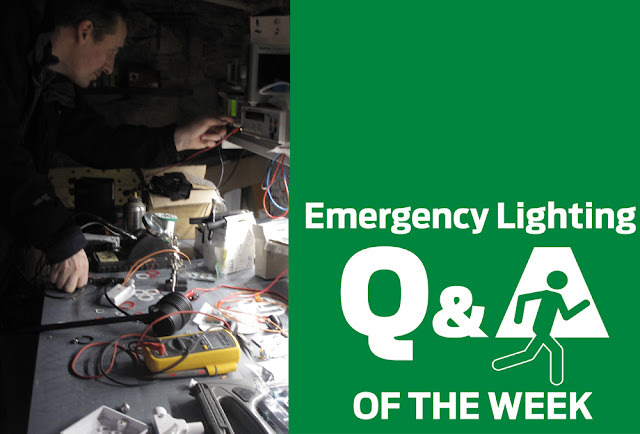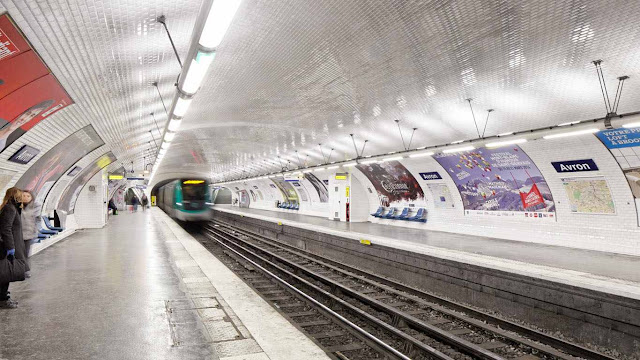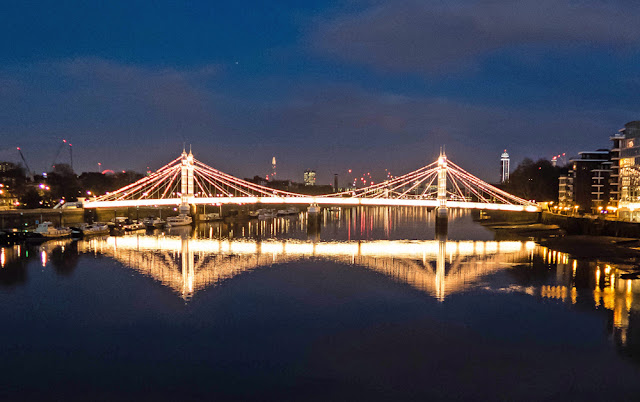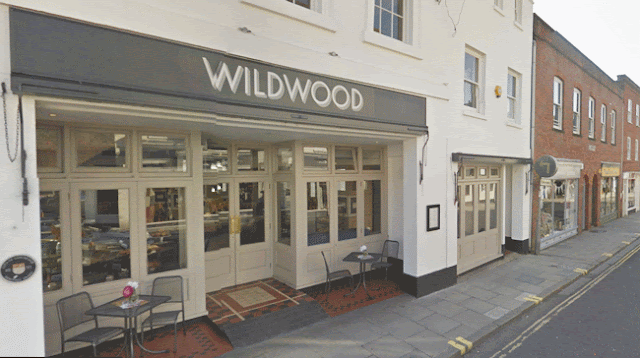Archive for June 2016
 |
| This question was answered by Jonathan Bell, commercial director of Liteplan Limited. |
Finding energy savings on a scheme that utilises GU10 or T8 fluorescent fixtures tends to be considered as the low hanging fruit of lighting upgrades. Emergency lighting requirements however, are often left to the last minute leading to a panic purchase whilst installation takes place. Occasionally there are compatibility issues too.
A conventional emergency conversion relies on a connection to the low voltage cables found between the driver and the LED load. In the case of GU10 and T8 LED tubes access to these cables is not possible. To solve this problem an emergency pack is needed to power the primary side of the driver.
In some cases a cost effective emergency control gear will be capable of carrying out the task, however at the other end of the spectrum, the driver can only be powered by pure sine wave AC. Not only is this option incredibly expensive, but the pack can be extremely bulky.

There are a vast choice of GU10 and T8 LED lamps available, a majority of which are compatible for use with smaller emergency packs. It is important though to check compatibility with your emergency lighting control gear before making a purchase.
 Tube manufacturers are well known for the constant evolution of their designs, however, when carrying out upgrades, small components within the driver are often changed, leading to a knock-on effect on compatibility with emergency control gear.
Tube manufacturers are well known for the constant evolution of their designs, however, when carrying out upgrades, small components within the driver are often changed, leading to a knock-on effect on compatibility with emergency control gear.
It is therefore crucial that a record is kept of part numbers and batch codes. Emergency lighting control gear manufacturers should have an extensive database of test results available to help you further with this issue.
Visit www.novelenergylighting.com today to explore LED emergency fittings and packs
emergency exit sign · emergency lighting · led emergency · led lighting · liteplan · Novel Energy Lighting
28
Government invests £5 million to help keep the lights on
Comments off · Posted by admin in LED, LED downlights, LED panels

Sainsbury’s is one of a number of companies to bid for an Electricity Demand Reduction grant, as Whitehall eyes ways to keep the lights on in winter.
The Government is investing nearly £5 million to encourage leading UK firms such as Sainsbury’s, to install energy efficient lighting.
The money is part of an attempt by Whitehall to reduce peak time energy levels as fears rise that the National Grid will not be able to cope with electricity demands this winter, leading to nationwide blackouts.
A string of leading companies, including British Gas, Sainsbury’s, Sony and BAE Systems, have bid for funding in the second auction of the Electricity Demand Reduction (EDR) pilot.
Plumbing firm Wolseley UK received an EDR grant of £100k and is using the money to kit out its distribution centre with upgraded LED lighting.
The company claims that the new fixtures will reduce its electricity demand by 236,000 kWh, which is enough energy to power more than 300 homes.
Wolseley worked closely with Cloudfm on the maintenance work, a partnership that has also led to Wolseley’s head office in Leamington Spa being awarded a BREEAM “Excellent” rating.
The scheme works by encouraging consumers to provide capacity in the form of megawatts to help the UK meet its energy efficiency targets and reduce pressure on the National Grid. The pilot also reduces the energy bills of those involved.
The Government had originally allotted £6 million to the pilot, but a lack of uptake meant that not all the money was allocated.
This is the second time that an EDR auction has failed to reach its target, the first, held last year, saw only £1.28m out of a total of £10 million being snapped up.
edr · electricity demand reduction · energy reduction · LED downlights · LED lamps · led lighting · led panels · LED retrofit · led tubes · Novel Energy Lighting
23
Paris edges closer to Li-Fi revolution
Comments off · Posted by admin in LED, LED Floodlights, LED Spots
led bridge lighting · led lighting · li-fi · lifi · Novel Energy Lighting · paris lifi · paris metro

Continued testing on LiFi capabilities are in train prior to a long-anticipated roll-out of the system in Paris Metro stations.
A French firm has won the contract to supply internet-over-lighting technology on the Paris Metro.
The ambitious project – which will allow over two million daily commuters to use lights as a form of Wi-fi, dubbed ‘Li-fi’ – now looks firmly on track. Already La Defense station has been successfully equipped with the tech.
Paris-based Oledcomm, a spin-off of the University of Versailles, won the contract from RAPT to initially supply Li-fi installations in 66 stations across Paris, involving over 250,000 LED luminaires.
The award of the contract by RATP follows an extensive series of test phases before the roll-out goes ahead. The first phase of the work involved a series of evaluations to prove the concept. This work was done in a so-called Fab Lab environment, community-based workshops where entrepreneurs, students, small businesses come together to develop technology.
The system needed to demonstrate that it could deliver on its core promises of a Li-fi installation, especially on four key criteria:
- The Li-fi can operate within a complex physical environment
- The system can provide the bi-directional communications needed for a secure internet connection
- Traffic and security information can be ‘pushed’ to smart phones as necessary
- A system of audio-messaging could be developed to enable tourists and people with impaired sight to be guided around the tunnels and concourses of an underground station
The Fab Lab process also presented commercial opportunities to other entrepreneurial groups to use the open-source nature of the system to develop apps that could work alongside the core Li-fi service.
Having successfully completed the test-house phase, the next phase of the contract moved into the real world with an installation of Li-fi-enabled LED luminaires at the Metro station at La Defense.
Chosen for its complexity, La Defense provides all of the real-life difficulties that a Li-fi installation will need to overcome if it’s to prove its worth to the transport system operators.
Once all of the testing has been successfully completed and RATP is confident of the platform, it’s expected that Paris will become the first public transportation system in world with Li-fi connectivity.
Oledcomm, formed in in 2005, installed its first public Li-fi project at the Musee Curtius in Liege in 2012. Since then, the company has gone on to install systems in offices, hospitals, retail stores as well as public street lighting.
Li-fi works by making invisible modulations to the light from a luminaire – invisible to the human eye, but not to the camera on a smartphone, tablet or laptop. The same technology lies behind the positioning systems being used by retailers such as Carrefour and Target, but here it is being used to send data, rather than just to pinpoint someone’s position. Proponents of Li-fi say that it will add enormous capacity to wireless communications, because the visible light spectrum is 10,000 times larger than the radio frequency spectrum that Wi-fi uses. Some also note that it will operate much faster than Wi-fi, and that it will be useful in electromagnetic sensitive areas like hospital, airplanes and nuclear power plants.
It’s currently not clear how devices will communicate back to the lighting on the Paris Metro installation. However, it is relatively straightforward to use different wavelengths for each link direction, i.e., visible light in the downlink (to also serve as illumination) and infrared or even standard Wi-fi in the uplink.
On the downside, Li-Fi signals do not travel as far as Wi-Fi signals do.
led light communications · led lighting · led subway · li-fi · lifi · metro lighting · Novel Energy Lighting · railway lighting · station lifi · station lighting
22
Seventeen London bridges to be lit in £20m project
Comments off · Posted by admin in LED, LED Floodlights

The project will be funded by private sponsors with the Mayor’s office and lighting enthusiast Lord Rothschild already donating £1 million to the contest.
Lighting designers are being asked to submit ideas for an ambitious £20 million plan to turn the Thames into a river of light.
Unveiled by Mayor of London Sadiq Khan and dubbed the ‘Illuminated River’, the project will see every major bridge between the Albert bridge and Tower bridge lit up in spectacular nightly display.
City Hall is inviting lighting designers, engineers and architects to submit ‘environmentally friendly and visually stimulating’ ideas for the scheme by 7 July.
The project will be funded by private sponsors with the Mayor’s office and lighting enthusiast Lord Rothschild already donating £1 million to the contest.
This project is unprecedented in its boldness and imagination’
Hannah Rothschild of the Illuminated River Foundation
Hannah Rothschild of the Illuminated River Foundation told the Evening Standard. ‘This is an opportunity to influence and transform the look, identity and experience of the world’s greatest city.’
It’s expected the prestigious competition will draw submissions from some of the world’s top lighting design practices. Bridges included are Westminster, Blackfriars, Millennium, Waterloo, Hungerford, Cannon Street, Chelsea and two proposed crossings, The Garden Bridge and Nine Elms Bridge.
Some structures are already lit and entrants are asked to incorporate or modify the existing lighting in their proposals.
Khan said he hoped Illuminated River will become the world’s longest outdoor permanent art gallery.
The competition closes on the 7July. Shortlisted schemes will go on public display with the winner announced at the end of the year.
For the full brief and more information see www.illuminatedriver.london
Picture: Charles D P Miller
bridge lighting · illuminated river · led lighting · london led · Novel Energy Lighting · outdoor lighting
Defective emergency lighting fixtures have landed The Wildwood restaurant chain in court.
The Chichester branch of the restaurant has been successfully prosecuted for breaching safety legislation after Fire Safety Officers found a number of infringements during an inspection.
As well as faulty emergency lighting, Officers also discovered blocked fire exits, dangerous electrics and the absence of a working fire alarm.
The Wildwood was fined £13,452 and ordered to pay £1,962 costs at Worthing Magistrates Court after pleading guilty to four charges under the Regulatory Reform (Fire Safety) Order 2005.
Visit http://www.novelenergylighting.com/catalogsearch/result/… to explore our range of emegency led lighting products
emergency exit sign · emergency led · emergency lighting · exit lighting · led lighting · Novel Energy Lighting
church led · church lighting · led lighting · led smart sensors · lux today · Novel Energy Lighting · osram led · osram lighting
10
Two-minute explainer: Tunable-white LEDs
Comments off · Posted by admin in LED, LED downlights, LED panels, LED Spots

Tunable-white lighting is one of the biggest trends in commercial lighting. LED developers have taken a serious grip on the photo-biological research being produced by university departments and other groups. We know more about the way that humans function than ever before and you might say that it’s fortunate for the LED community that the science appears to support a practical technology that is perfectly suited to LED exploitation.
Tunable whites use colour mixing
Standard LED colour-mixing uses red, green and blue channels that are adjusted to deliver the entire range of the colour spectrum. Tunable-whites work in the similar way, using of a number of controllable channels to adjust the colour temperature of the luminaire’s white light output. The channels in a tunable-white system all produce white light, but with varying colour temperatures, from a warm tone to a cool tone.
Inevitably, there are levels of sophistication involved in tunable-white systems and it’s vital that the specifier understands not only what is required from the lighting, but also what any particular system is capable of delivering.
Simple systems use two lines of LEDs
Take a warm white LED and sit it next to a cool white LED and cross-dim between the two. Job done? Well, not quite. It’s true that the cheapest tunable whites work in exactly this way. The most basic tunable linear systems use LED strips mounted side-by-side. One channel will be close to 2700K in colour temperature, with the other up around a cool 6000K. The LED strips are mounted inside an aluminium extrusion fitted with an opal diffuser, which does the colour mixing as the light passes through it. It’s very simple engineering but satisfies a basic market with low performance expectations.
Multi-chip versions do the mixing at chip level
More products are using ‘multi-chips’ where a number of tiny LED chips are combined into the same module. This means that the colour mixing occurs as the light leaves the module. Their very small size means that tunable-white products can be made much smaller, so we’re starting to see downlights using the technology as well as linear systems. These multi-chips tend to have a higher performance specification than the individual LED strips, but nothing should be left to chance.
Colour rendering can be compromised
A lot of fuss is made, quite rightly, over the way that white light presents surface colours. We’ve come to expect a good quality of colour rendering, regardless of light source. Tunable whites are not exempt from this issue but it’s not always clear from manufacturers’ data how well a system is performing.
Cheaper products may advertise good colour performance at the extremes of the tunable range, where light is being delivered from either the warm or the cool channel, but there’s no certainty that the mixed light performs equally well. Generally speaking, the greater the number of channels, and systems vary from two-channel to five-channel, the better colours will look under them.
Not all tunable-white systems cover the same colour range
If there is one aspect of tunable-whites that the specifier needs to take great care over, it’s the colour temperature range that’s on offer. While some systems offer a wide natural ‘circadian rhythm’ range that shifts from candlelight to daylight, there are other systems with a much smaller range, from 2500K to 4000K, which should only be considered as a decorative option.
There are three ways to control the tones
- The simplest systems use manual control to alter the white outputs. Expect to see a wall-mounted control panel or a hand-held remote control that enables you to adjust the colour of the light and the amount of light output. There is nothing scientific about this. It’s left entirely to personal preference, which may – or may not – be a good thing.
- Some tunable controls are designed to replicate the effect of dimming on a filament source, where two things happen at the same time. As the light output is dimmed, the lamp warms up in the same way as a traditional tungsten filament lamp. This is still a manual control method, but has the benefit of mimicking a filament light source. The tunable range tends to be very small, again mimicking the conventional tungsten lamp.
- More sophisticated control strategies are designed to manipulate the circadian rhythm of room occupants. This means that the lighting settings are programmed into the control architecture. Shifts in colour temperature and light level can be pre-set or can be instigated by a manual over-ride. This is the method that’s being used in recent school installations in Scandinavia.
Three discrete channels could be a solution
It’s been pointed out that not all ‘tunable-white’ mixing requires a full colour range. Complex tunable-white schemes mean that you should be able to call up any colour temperature within the mixing range. But some clients will call for specific colour temperatures, often those that are commercially available, such as 3000K, 4000K, 6500K. If that’s the case, then it may be simpler – and cheaper – to consider having three discrete lighting channels operating separately within a bespoke housing.
Photo credit: Glamox Luxo
colour temperature · LED downlights · led lighting · led panels · Novel Energy Lighting · school lighting · tunable light · tunable wite light
Philips recalls thousands of metal halide lamps over ‘burn and laceration’ dangers. PLUS: The latest business news including acquisitions. Lux Today webcast for 31 May 2016 is presented by Courtney Ferguson.
LED · lux reports · metal halide · Novel Energy Lighting · philips ipo · philips lighting · zika virus
Lux reports: A tech revolution is happening in lighting – and the speed of development is blistering. Here we identify the biggest trends you need to know about. And a few are rather surprising….
 1 Indoor location tracking
1 Indoor location tracking
The latest tech uses lights in conjunction with smart phones to accurately locate people with 10cm accuracy within an indoor space. Once the building owner knows where you are, they can interact with you to deliver real time marketing messages or offer better services, or perhaps they’ll just track what you do and figure out how to use the data.
Who to watch: Acuity Brands, Philips
 2 Camera-based lighting control
2 Camera-based lighting control
Lighting controls today typically use infrared, ultrasonic or microwave sensors to detect movement, which means they are liable to false triggering or switching prematurely when people aren’t moving. Camera technology is so cheap (you probably have two in your smart phone) that they are now being used in lighting control.
Who to watch: EWO, Zumtobel, Steinel, Hubbell
 3 Self-learning control systems
3 Self-learning control systems
The concept of a device learning its own settings has been pioneered by Google’s acclaimed Nest Labs in its thermostats. The concept lends itself perfectly to lighting controls so that sector is examining how the approach can be adopted to enable the system to self-commission and learn how a space is being used over time.
Who to watch: Helvar
 4 Super capacitors
4 Super capacitors
The Achilles’ heel of emergency lighting is batteries, which degrade over time. However, the improvements in efficiency of LEDs and advancing capacitor technology mean it is possible to get an hour of lighting back-up without batteries. This means that emergency lighting can have a maintenance free life of up to 10 years.
Who to watch: Teknoware, Ledo
 5 Integrated street lights
5 Integrated street lights
Street lights or rather the columns which hold them off the ground used to be a convenient place for dogs to use as toilets, now they’re being crammed full or other technology from CCTV systems, PA speakers, Wifi transmitters and electric car charging points. This reduces street clutter and could provide funding streams for public lighting.
Who to watch: Schreder, Hess, Philips
 6 Inductive power coupling
6 Inductive power coupling
Although this technology has been around for years – it’s used to charge your electric toothbrush – manufacturers are now exploring ways in which it can used for lighting. It’s a perfect way to install an unground uplight and avoid the age old issue of water ingress, or connect a retail lighting display to power without wires.
Who to watch: Auraled, Design LED Products
 7 DC power networks
7 DC power networks
The battle of the currents was settled in favour of AC back in the 1890s, but LEDs and a proliferation of low-power devices mean Round Two has started. Power over Ethernet (PoE) is one embodiment bundled up as part of a computer network, but we’ve also seen DC-powered track lighting, which results in smaller fixtures.
Who to watch: Cisco, Zumtobel
 8 Lights which aren’t just lights
8 Lights which aren’t just lights
With sensors becoming so cheap, and lights getting connected to the Internet, light fixtures are starting to get packed out with sensors not related to lighting, such as ambient temperature and air quality. That data can be shared with other building services or harvested for other big data applications.
Who to watch: Gooee, Sensity Systems, Acuity Brands
 9 Miniaturisation
9 Miniaturisation
Everything in lighting is starting to shrink dramatically. Think chip-scale LED arrays, compact optical systems and ultra thin LED drivers (the smallest we’ve seen is just 13mm high). This should result in ultra-small downlights, in-ground uprights and super-slim linear fixtures, and lower materials costs for the manufacturer.
Who to watch: Lumileds, Samsung, Osram, iGuzzini
 10 Li-Fi
10 Li-Fi
Wi-fi over lighting, or Li-Fi to give it the name coined by inventor Harold Haas, can transmit data 100 times faster than wifi by modulating the light, which would mean you could download the entire set of Star Wars movies in around one second. It works by pulsing the LED light at extremely high frequencies which is undetectable to the human eye.
Who to watch: PureLifi, Toshiba
dc power networks · google nest · indoor location tracking · inductive power coupling · integrated street lights · lifi · lighting trends · Novel Energy Lighting · super capacitors · wifi lighting




